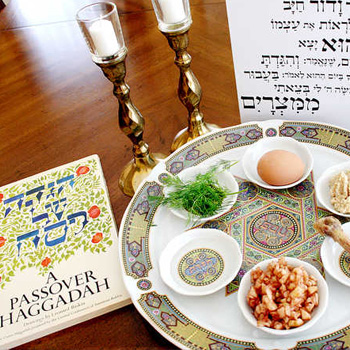THE SEARCH FOR LEAVEN
Bedikat Chometz or the search for leaven, is the ritual prescribed for the night before Passover. This year, Bedikat Chometz occurs on Sunday evening, April 13 2014. In order to be certain that the house is ready for the holiday, the head of the house searches carefully in all the rooms for any remaining leaven. Since the house has been thoroughly purged, a member of the household customarily places small pieces of bread in conspicuous places around the house. After the blessing is recited, one goes from room to room, carrying a lighted candle, a wooden spoon and a feather. The rest of the family, following, watches him sweep the bread onto the spoon with the feather. The special blessing pronounced at this time is:
“Baruch at-ta Ado-Nai, Elo-Heinu Melech ha’olom, asher kidshonu b’mitzvosav, v’tzivanu, al bi-ur chametz.”
“Blessed art thou, O, L-rd, Our G-d, King of all the Universe, who has commanded us to remove all leaven.”
After the search is completed another prayer is said:
“All manner of leaven that is in my possession which I have not seen or removed shall be null and accounted as the dust of the earth.”
All the chometz found is placed in a bag and put away until the following morning when it is burned. After the burning of the chometz, no leaven is eaten for the entire eight days of Passover.
Some Laws of Kashering on Pesach
The following is a basic outline for koshering your kitchen for Pesach. For specific Passover questions, please contact Rabbi Perton.
Utensils (From www.ou.org)
Kashering utensils for Pesach should preferably be completed before the fifth hour on Erev Pesach of a regular year, and on Friday in a year when Erev Pesach falls on Shabbos. Not all materials can be kashered. Vessels made of wood, stone, natural rubber and metal may be kashered. However, items made from plastic, melmac, nylon, china, earthenware, porcelain, glassware used for cooking and baking, Corningware, Corelle, Pyrex, Duralex, Formica, enamel, enamel covered pots, Teflon, and Silverstone cannot be kashered. Sieves, strainers, graters, grinders, rolling pins, kneading boards, utensils that have rust and dirt that cannot be removed or cracks, crevices and patches may not be kashered for Pesach.
The underlying principle for kashering is that the way that the prohibition was absorbed is the way that it will be removed. For example, if the vessel absorbed chometz by being cooked on a stove in a liquid, then that is the way that the vessel will expel chometz. Therefore, there are different methods of kashering vessels.
The first method which is used for pots on the fire and stirring spoons and the like is called “hagallah”, or purging through boiling.
The second method used for kashering of utensils is called “libun”, which is done on utensils which were used with fire or heat without water, i.e. spits, baking pans, etc. Libun requires one of two methods: either a thorough libun or simple libun. A thorough libun requires the heating of the vessel until it becomes red-hot, whereas simple libun requires that the heat penetrate sufficiently throughout the entire vessel. Another method of kashering utensils is for glass utensils that we use for cold items. This is done by a 72 hour immersion and refilling in regular water. For details of these methods of kashering the Rabbi should be consulted. It is preferable, when possible, to use dishes, cutlery, glasses, pots and pans that are especially set aside for Pesach which have never come in contact with chometz. However, under certain conditions, some of the utensils used throughout the year may also be used on Pesach if they are properly kashered (made kosher).
Ovens: Self-cleaning: The self-cleaning oven is relatively easy to kasher. First, clean the stove thoroughly. Second, turn the oven to self clean and set the times for a half hour longer than the oven has ever been used.
Ovens: Non-self cleaning: The oven must be cleaned thoroughly (as if you were going to resell it) including the racks, with a caustic cleaner and left for 24 hours. Then you should turn the oven to the highest setting and leave it on for approximately 1 hour.
Microwave: Do not use oven for 24 hours. Thoroughly clean all the surfaces in the oven. The insert tray should be covered with cardboard or Styrofoam. Place a utensil with water in the microwave bringing it to a boil.
Stoves: Electric: The burners should be turned on to the highest heat and left for a few minutes after they turn red.
Stoves: Gas: The grates should be cleaned and either kashered in the oven or by keeping the grate over the fire, on each side, for 10 minutes. Corning cooking range: Allow it to heat up until the entire range top is very hot.
Stove Tops: Enamel: Can not be kashered. The top should be cleaned and covered with heavy aluminum foil.
Stove Tops: Stainless Steel Top: Do not use for 24 hours, clean with a caustic cleaner and then pour boiling water from a pot or kettle over the entire area, ensuring that every part of the stove top is reached by the water.
Pans and rings made of metal: May be kashered by leaving for 24 hours and then either purged in boiling water, or kashered with the self cleaning oven.
Refrigerators and Freezers: Wash out thoroughly.
Dishwashers: Unless it is stainless steel with new racks, it should not be used on Pesach.
Broilers, Toaster Ovens, Food Processors, Mixers, Coffee Makers are very hard to kasher for Pesach. In case of great need, contact the Rabbi.
Sinks: Stainless steel: Don’t use hot for 24 hours and then kasher by pouring boiling water from a pot or kettle over every area of the surface of the sink.
Enamel: Can not be kashered. Clean them thoroughly and line with tinfoil and a sink insert.
Counter Tops: Unless stainless steel, can not be kashered and should be completely cleaned and covered (i.e. with contact paper or foil.)
Tablecloths, Dish towels: Tablecloths and dish towels that have come in contact with chometz may be used on Pesach provided they were thoroughly washed before the holiday. Starched tablecloths, however, may not be used on Pesach at all, because starch may contain flour.
The following is a partial list of those items that can be kashered for Pesach and the type of method that is used to kasher them. Pots (which were used to cook chometz in liquid) – Hagallah Spits and baking pans (which were used over the fire without liquid) – Libun gamur Frying Pans – Libun
The Seder Plate
- THE Z’ROAH: A roasted shank bone, representing the ancient sacrifice of the pascal lamb (korban Pesach) which was eaten roasted. Pesach, the Hebrew name for Passover, also refers to the L-rd’s passing over (Pesach) the Jewish homes during the plague which was visited upon the Egyptian first-born.
- THE BEITZAH: A roasted egg, placed to left of the Z’roah, symbolizes the required offering on all festivals in the Temple. The egg, while not itself sacrificed, is used in the Seder as the Jewish symbol of mourning (in this case, the loss of the Temple.)
- THE CHAROSET: Placed beneath the Z’roah is a mixture of chopped apple, nuts, cinnamon and wine, designed to look like the mortar used by the Jews in the building of the storage houses and pyramids while they were in bondage.
- THE MAROR: Or bitter herbs, usually Horseradish or Romaine lettuce, is placed in the centre of the platter, symbolizing the Jewish People’s bitter suffering under the Egyptian yoke.
- THE KARPAS: A piece of parsley, potato or celery, placed to the left of the Charoset. It is dipped into salt water in remembrance of the tears shed in their misery. These five items are assembled, as directed, on a circular platter.
The Table Setting: A plate or tray with three pieces of matzoh is placed in front of the platter covered with a white cloth, or a special matzoh cloth, if available. The three matzoh represent the three divisions of the Jewish People: Kohanim, Leviim and Yisraelim. The center matzoh is broken in half and the hidden portion is called the Afikoman. The child who finds the broken matzoh is usually rewarded with a gift. This is eaten at the end of the meal. The name Afikoman is actually derived from a Greek synonym meaning dessert.
COUNTING THE DAYS OF OMER
The Omer, Beginning with the second night of Passover, and continuing for forty-nine nights, we count the Omer, in accordance with the Biblical injunction: “From the morrow of Pesach, from the days of your bringing the Omer, you shall count seven full weeks.” The Omer was a special offering of barley gathered from the newly ripened grain which then permitted the use of the spring harvest.
In Temple times, the harvesting of the Omer on the second night of Pesach was an occasion for great celebration in the streets of Jerusalem. The counting of the Omer must take place after nightfall. Immediately before starting the daily and weekly number in the Omer, we recite the benediction ‘Al Sephirat Ha-Omer.’ These forty-nine days link the festival of Passover, the celebration of our physical redemption with the festival of Shavuot, which occurs on the 50th day, when we celebrate our spiritual redemption, the giving of the Torah at Mt. Sinai. In the second century of the Common Era, Eretz Yisrael was visited by a plague. Thousands of the disciples of Rabbi Akiva perished at the time during the period between Pesach and Shavuot. In their memory, this period is observed with partial mourning. During the weeks of the Omer, therefore, we do not make weddings feasts nor engage in unusual festivity, nor do we cut our hair. Since the plague stopped on the thirty-third day of the Omer (Lag B’Omer), these restrictions are suspended for that day. This year, Lag B’Omer occurs Sunday, May 18, 2014.
CHOL-HAMOED (THE INTERMEDIATE DAYS)
The intermediate days consist of the four intervening days during the Holiday, when all the laws of Passover apply. Work is permitted except of course, on the Sabbath. During the week of Passover, prayers and appropriate portions of the Torah and Prophets are read in the Synagogue. On the morning of the first day the “Tal,” or “Dew” prayer is chanted, asking for abundant dew in Israel during the summer months when no rain falls there. The Hallel is recited daily, as a recitation of praise and thanksgiving compiled from the Psalms of King David. On the last day of Passover, the Yizkor Memorial Service for the departed is recited by the worshippers of the Congregation. One must be mindful of the fact that no leaven should be purchased until the conclusion of the Eighth Day of Pesach.







